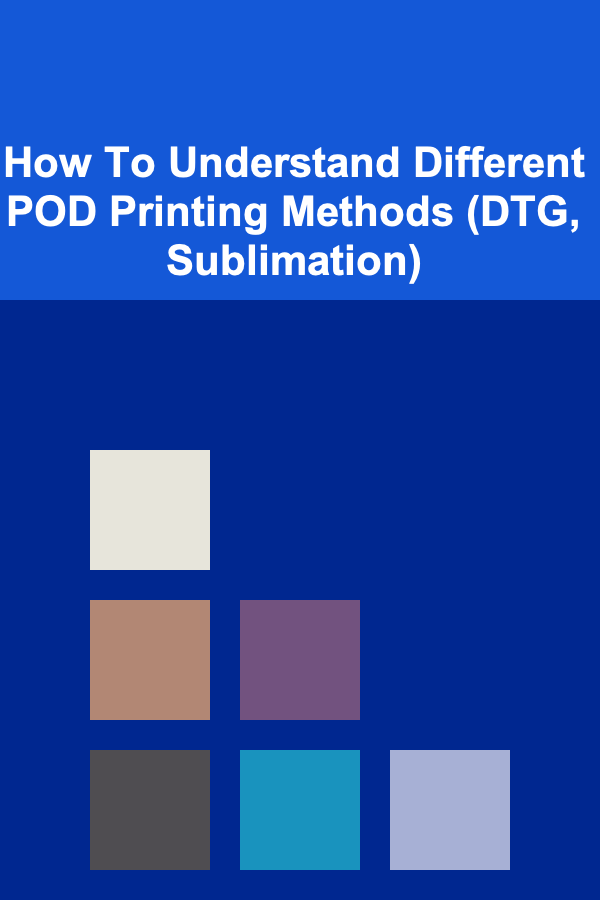
How To Understand Different POD Printing Methods (DTG, Sublimation)
ebook include PDF & Audio bundle (Micro Guide)
$12.99$6.99
Limited Time Offer! Order within the next:

Print-on-demand (POD) is a rapidly growing industry that allows individuals and businesses to create custom products without maintaining large inventories. The rise of e-commerce platforms like Etsy, Shopify, and Amazon has fueled this growth, offering entrepreneurs the ability to design and sell unique products to global markets. Among the various POD printing methods, Direct-to-Garment (DTG) and Sublimation stand out as two of the most popular options.
These printing techniques differ in their application, materials, and the type of products they can produce. Understanding the advantages, limitations, and ideal use cases for each method is essential for anyone looking to enter the POD space. This article will provide an in-depth exploration of DTG printing and Sublimation, examining their processes, applications, and benefits.
What is Print-on-Demand (POD)?
Before diving into the specifics of DTG and Sublimation, it's important to understand what Print-on-Demand entails. POD is a business model where products are only printed after an order is placed. This eliminates the need for upfront investment in inventory and reduces the risk of overstocking or understocking products. POD businesses typically focus on custom apparel, accessories, and home decor, but the potential extends to a wide variety of products, such as books, phone cases, and mugs.
The POD process involves creating designs, selecting products, and using a printing method to transfer those designs onto the items. The key benefit of POD is that it allows individuals to start a business without significant upfront costs. However, the printing method chosen can affect the quality, cost, and product variety offered to customers.
Overview of DTG Printing
Direct-to-Garment (DTG) printing is a method that uses specialized inkjet technology to directly print designs onto fabric. It's primarily used for apparel like T-shirts, hoodies, and other clothing items. DTG is best suited for designs that are complex, colorful, or feature gradients, as it can handle high levels of detail and a broad color spectrum.
How DTG Works
- Design Creation: The first step in DTG printing is creating the design digitally, typically using software like Adobe Illustrator or Photoshop. Once the design is finalized, it is converted into a format that can be read by the DTG printer.
- Pre-Treatment: For cotton-based fabrics, a pre-treatment solution is applied to ensure the ink adheres properly to the garment. This treatment is especially crucial for dark-colored garments, where the ink needs a white underbase layer to stand out.
- Printing: The garment is placed on a platen, and the DTG printer sprays ink directly onto the fabric. The ink used is typically water-based, which makes it soft and flexible, as opposed to traditional screen printing inks.
- Curing: After the design is printed, the garment is cured using heat. This process ensures the ink sets properly, making the print durable and resistant to washing.
Advantages of DTG
- High-Quality Prints: DTG is known for producing high-resolution prints with intricate details, making it ideal for designs that require fine details and gradients.
- No Minimum Orders: Since the printer only prints on demand, there are no minimum order requirements. This makes DTG an excellent option for small businesses and individual designers.
- Soft Finish: The water-based inks used in DTG printing provide a soft finish that doesn't feel like a thick, heavy layer of ink on the fabric.
Disadvantages of DTG
- Limited Fabric Choices: DTG printing works best on 100% cotton or cotton-blend fabrics. It may not produce the best results on synthetic fabrics like polyester.
- Slower Production: Compared to other printing methods like screen printing, DTG is slower, particularly for large batches, as each item is printed individually.
- High Ink Cost: The inks used in DTG can be expensive, especially for large designs or full-color prints. This may increase the production cost of each item.
Overview of Sublimation Printing
Sublimation is another popular printing method used in the POD industry, particularly for products that require vibrant, all-over prints. Sublimation works by turning solid dye into a gas without passing through a liquid state (this is known as sublimation). The dye then bonds with polyester fibers, creating a permanent, vibrant image that won't fade or peel over time.
How Sublimation Works
- Design Creation: Like DTG printing, sublimation requires the creation of a digital design. The design is printed onto a special transfer paper using sublimation inks.
- Transfer Process: The transfer paper is placed on the item (usually polyester fabric or coated materials). Heat and pressure are applied through a heat press, causing the dye to sublimate and bond with the fibers of the material.
- Cooling: After the transfer process, the item is allowed to cool. The design becomes a permanent part of the fabric and will not fade, peel, or crack over time.
Advantages of Sublimation
- Vibrant and Durable Prints: Sublimation produces vibrant, full-color prints that are resistant to fading. Since the dye bonds with the fabric, it's highly durable and won't crack or peel.
- All-Over Printing: Sublimation allows for all-over prints, making it ideal for items like custom T-shirts, sportswear, and phone cases, where the design covers the entire product.
- Soft Feel: Since the dye becomes part of the fabric, there is no surface-level ink to feel. This gives sublimation prints a smooth, soft texture.
Disadvantages of Sublimation
- Fabric Limitations: Sublimation works only on polyester or specially coated items. It's not suitable for natural fabrics like cotton.
- Color Limitations on Dark Fabrics: Sublimation works best on white or light-colored fabrics, as the ink is translucent. This means that dark fabrics will not show vibrant designs as effectively.
- No White Ink: Unlike DTG printing, sublimation cannot print in white. This is a limitation when printing on dark fabrics or when white areas are part of the design.
Comparing DTG and Sublimation
While both DTG and Sublimation are effective POD printing methods, they cater to different needs based on the products and designs.
1. Product Compatibility
- DTG: Best suited for 100% cotton fabrics or cotton blends, making it ideal for custom T-shirts, hoodies, and other apparel made from natural fibers.
- Sublimation: Works only on polyester fabrics or products that have a special coating. This makes it ideal for all-over prints on polyester garments, mugs, phone cases, and other synthetic materials.
2. Design Complexity
- DTG: Perfect for designs with fine details, gradients, and multi-colored images. It's highly versatile in terms of the types of artwork that can be printed.
- Sublimation: Excellent for vibrant, full-color designs, especially those requiring all-over printing. However, it's not ideal for designs that need white ink or designs on dark-colored garments.
3. Durability
- DTG: Prints can be long-lasting but may fade over time with washing, especially if not properly cared for. The durability depends on the fabric and the inks used.
- Sublimation: Sublimation prints are extremely durable and fade-resistant, as the ink bonds with the fibers of the fabric. These prints won't peel, crack, or fade with time.
4. Printing Speed
- DTG: Slower printing process, especially for large quantities of products, as each garment is printed individually.
- Sublimation: Faster than DTG for printing large quantities, especially for designs that cover the entire garment or product.
Choosing the Right POD Printing Method
The choice between DTG and Sublimation depends on several factors, including the type of product, the design complexity, and the target market. Here are some considerations when choosing a printing method:
- Type of Product: If you're planning to print on cotton-based products, DTG is the best choice. For polyester or all-over prints, Sublimation is the preferred method.
- Design Requirements: For intricate, multi-colored designs with fine details or gradients, DTG is ideal. If you need vibrant, full-color prints or all-over designs, Sublimation is the better option.
- Durability Needs: If you want prints that will stand the test of time without fading, cracking, or peeling, Sublimation offers superior durability. DTG prints, though durable, may fade with frequent washing if not maintained properly.
- Production Volume: For small orders and individual designs, DTG printing works well, but for larger orders, Sublimation may offer faster production times and lower costs.
Conclusion
Both DTG printing and Sublimation printing have unique advantages that make them suitable for different types of products and designs. DTG is an excellent choice for printing on cotton garments with complex, colorful designs, while Sublimation shines in creating vibrant, all-over prints on polyester and synthetic materials.
As the POD industry continues to grow, understanding these printing methods will help you make informed decisions about which method best suits your business model, product line, and customer needs. Whether you're a small business owner, an aspiring designer, or an entrepreneur looking to break into the world of print-on-demand, knowing how these printing methods work can provide the foundation for success.

How to Choose the Best Insurance Plan for Your Needs
Read More
How to Decorate with Purpose: Choosing Meaningful Pieces
Read More
How to Use Geotargeting to Increase Conversion Rates in Dropshipping Ads
Read More
How To Research Topics for Authoritative Content
Read More
Using Data to Understand Climate Trends
Read More
How To Find a Viable Business Idea
Read MoreOther Products

How to Choose the Best Insurance Plan for Your Needs
Read More
How to Decorate with Purpose: Choosing Meaningful Pieces
Read More
How to Use Geotargeting to Increase Conversion Rates in Dropshipping Ads
Read More
How To Research Topics for Authoritative Content
Read More
Using Data to Understand Climate Trends
Read More